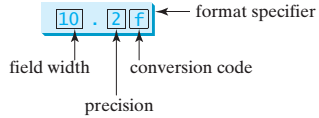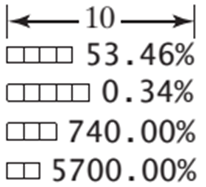Python入门示例系列17 输入与输出( 格式化输出 )
Python入门示例系列17 输入与输出
读取键盘输入(input)
Python 提供了 input() 内置函数从标准输入(键盘)读入一行文本,默认的标准输入是键盘。返回结果是字符串。
input 函数可以提示用户输入。
>>> astr = input("请输入:"); ## input('提示的内容') 请输入:123 >>> print(astr) ## astr 的类型为str 123
如果从键盘输入两个数字,并求这两个数字之和,该怎么写程序呢?
采用eval函数,可以把输入的数字(真实类型为字符串,如 "123" 实际为字符串类型)转变为数值类型(如:int,float等)。
a=input("请输入一个数字 ") b=input("请再输入一个数字 ") print("求和结果 ", eval(a)+eval(b)) # 为什么不是 a+b ?
eval(expression)
eval函数解析expression参数并将其评估为python表达式。换句话说,我们可以说这个函数解析了传递给它的表达式并在程序中运行python expression(code)。
为了评估基于字符串的表达式,Python的eval函数运行以下步骤:
解析表达式
编译成字节码
将其评估为Python表达式
返回评估结果
输出
在屏幕上输出,可以采用print函数。print函数可以在屏幕上显示一句话。
下面介绍格式化字符串的方法,所谓格式化字符串,就是控制输出内容的格式。
只想快速显示变量进行调试,可以用 str() 函数把值转化为字符串。
在Python 3.6之前,有两种将Python表达式嵌入到字符串文本中进行格式化的主要方法:%-formatting和str.format()
从Python 3.6开始,f-string是格式化字符串的一种很好的新方法。与其他格式化方式相比,它们不仅更易读,更简洁,不易出错,而且速度更快。
% 字符串( "格式化字符串" % (输出值) )
示例1:
name = "Eric" s="Hello, %s." % name # s% 表示字符串的占位符 print(s)
结果:
Hello, Eric.
示例2:
name = "Eric" age = 74 s="Hello, %s. You are %s." % (name, age) # s% 表示字符串的占位符 print(s)
结果:
Hello, Eric. You are 74.
print('%x, %X' % (12, 15))
print('[%c]' % 97)
缺点:
使用几个参数和更长的字符串,代码将很快变得不太容易阅读。不能正确显示元组或字典。
str.format() "格式化字符串".format(输出值)
在Python 2.6中引入的。
该方法也用 { 和 } 标记替换变量的位置,虽然这种方法支持详细的格式化指令,但需要提供格式化信息。
示例:
print("{0},{1},{2}".format(1,2,3)) print("{2},{1},{0}".format(1,2,3)) print("{1},{1},{1}".format(1,2,3)) print("{0:b},{1:x},{2:o}".format(1,12,16)) # b 二进制 x 十六进制 o 八进制
结果:
1,2,3 3,2,1 2,2,2 1,c,20
标准格式说明符 的一般形式如下:
format_spec ::= [[fill]align][sign][#][0][width][grouping_option][.precision][type] fill ::= <any character> align ::= "<" | ">" | "=" | "^" sign ::= "+" | "-" | " " width ::= digit+ grouping_option ::= "_" | "," precision ::= digit+ type ::= "b" | "c" | "d" | "e" | "E" | "f" | "F" | "g" | "G" | "n" | "o" | "s" | "x" | "X" | "%"
各种对齐选项的含义如下:
|
选项 |
含意 |
|---|---|
|
|
强制字段在可用空间内左对齐(这是大多数对象的默认值)。 |
|
|
强制字段在可用空间内右对齐(这是数字的默认值)。 |
|
|
强制字段在可用空间内居中。 |
对齐文本以及指定宽度:
>>> '{:<30}'.format('left aligned')
'left aligned '
>>> '{:>30}'.format('right aligned')
' right aligned'
>>> '{:^30}'.format('centered')
' centered '
上面的代码指定输出字符串的宽度为30个字符。
sign 选项仅对数字类型有效,可以是以下之一:
|
选项 |
含意 |
|---|---|
|
|
表示标志应该用于正数和负数。 |
|
|
表示标志应仅用于负数(这是默认行为)。 |
width 是一个定义最小总字段宽度的十进制整数,包括任何前缀、分隔符和其他格式化字符。 如果未指定,则字段宽度将由内容确定。
precision 是一个十进制数字,表示对于以 'f' and 'F' 格式化的浮点数值要在小数点后显示多少个数位,或者对于以 'g' 或 'G' 格式化的浮点数值要在小数点前后共显示多少个数位。
'{:20.4f}'.format(123.456789) ' 123.4568' '{:20.4F}'.format(123.456789) ' 123.4568'
type 确定了数据应如何呈现。
可用的字符串表示类型是:
类型
含意
's'字符串格式。这是字符串的默认类型,可以省略。
示例
'{:30s}'.format("abcde") 'abcde ' '{:<30s}'.format("abcde") 'abcde ' '{:>30s}'.format("abcde") ' abcde' '{:^30s}'.format("abcde") ' abcde
可用的整数表示类型是:
|
类型 |
含意 |
|---|---|
|
|
二进制格式。 输出以 2 为基数的数字。 |
|
|
字符。在打印之前将整数转换为相应的unicode字符。 |
|
|
十进制整数。 输出以 10 为基数的数字。 |
|
|
八进制格式。 输出以 8 为基数的数字。 |
|
|
十六进制格式。 输出以 16 为基数的数字,使用小写字母表示 9 以上的数码。 |
|
|
十六进制格式。 输出以 16 为基数的数字,使用大写字母表示 9 以上的数码。 在指定 |
示例
'{:20b}'.format(111) ' 1101111' '{:20d}'.format(111) ' 111' '{:20o}'.format(111) ' 157' '{:20x}'.format(111) ' 6f'
float 和 Decimal 值的可用表示类型有:
|
类型 |
含意 |
|---|---|
|
|
科学计数法。 对于一个给定的精度 |
|
|
科学计数法。 与 |
|
|
定点表示法。 对于一个给定的精度 |
|
|
定点表示。 与 |
|
|
百分比。 将数字乘以 100 并显示为定点 ( |
示例
'{:20.4e}'.format(123.456789) ' 1.2346e+02' '{:20.4E}'.format(123.456789) ' 1.2346E+02' '{:20.4f}'.format(123.456789) ' 123.4568' '{:20.4F}'.format(123.456789) ' 123.4568' '{:20.4%}'.format(123.456789) ' 12345.6789%'
格式示例
按位置访问参数:
>>> '{0}, {1}, {2}'.format('a', 'b', 'c') 'a, b, c' >>> '{}, {}, {}'.format('a', 'b', 'c') # 3.1+ only 'a, b, c' >>> '{2}, {1}, {0}'.format('a', 'b', 'c') 'c, b, a' >>> '{2}, {1}, {0}'.format(*'abc') # unpacking argument sequence 'c, b, a' >>> '{0}{1}{0}'.format('abra', 'cad') # arguments' indices can be repeated 'abracadabra'
按名称访问参数:
>>> 'Coordinates: {latitude}, {longitude}'.format(latitude='37.24N', longitude='-115.81W') 'Coordinates: 37.24N, -115.81W' >>> coord = {'latitude': '37.24N', 'longitude': '-115.81W'} ## 字典 >>> 'Coordinates: {latitude}, {longitude}'.format(**coord) ## 字典 'Coordinates: 37.24N, -115.81W'
访问参数的项:
>>> coord = (3, 5) >>> 'X: {0[0]}; Y: {0[1]}'.format(coord) 'X: 3; Y: 5'
替代 %x 和 %o 以及转换基于不同进位制的值:
>>> # format also supports binary numbers >>> "int: {0:d}; hex: {0:x}; oct: {0:o}; bin: {0:b}".format(42) 'int: 42; hex: 2a; oct: 52; bin: 101010'
使用逗号作为千位分隔符:
>>> '{:,}'.format(1234567890) '1,234,567,890'
表示为百分数:
>>> points = 19 >>> total = 22 >>> 'Correct answers: {:.2%}'.format(points/total) 'Correct answers: 86.36%'
使用特定类型的专属格式化:
>>> import datetime >>> d = datetime.datetime(2010, 7, 4, 12, 15, 58) >>> '{:%Y-%m-%d %H:%M:%S}'.format(d) '2010-07-04 12:15:58'
缺点:
当处理多个参数和更长的字符串时,str.format()仍然可能非常冗长。
f' '
f-string, f 字符串
使用 格式化字符串字面值 ,要在字符串开头的引号(或三引号)前添加 f 或 F 。在这种字符串中,可以在 { 和 } 字符之间输入引用的变量,或字面值的 Python 表达式。
示例:
name="Sam" age=20 s=f'{name} is {age} yeas old.' print(s)
结果:
Sam is 20 yeas old.
可以将任何有效的Python表达式放入其中。
示例:
f"{2 * 37}"
name="Sam"
f"{name.lower()} is funny."
多行字符串:
name="Sam"
profession="teacher"
affiliation="XAUT"
message = (f"Hi {name}. " f"You are a {profession}. " f"You were in {affiliation}.") print(message)
结果
Hi Sam. You are a teacher. You were in XAUT.
format() 函数
示例

print ( format ( 57.467657, "10.2f" ) ) # f 表示浮点数;10表示总宽度;.2表示取二位小数,四舍五入 print ( format ( 12345678.923, "10.2f" ) ) #10表示宽度,2表示小数位数;如果实际占用宽度超过了给定的宽度,按实际宽度显示; print ( format ( 57.4, "10.2f" ) ) # 默认情况下,数字靠右对齐,左侧补空格; print ( format ( 57, "10.2f" ) )

print ( format ( 57.467657, "10.2e" ) ) # e表示科学计数法 print ( format ( 0.0033923, "10.2e" ) ) #10表示宽度,2表示小数位数 print ( format ( 57.4, "10.2e" ) ) #默认情况下,正负号占一位,指数占2位,不足2位前方补0 print ( format ( 57, "10.2e" ) )

print ( format ( 0.53457, "10.2%" ) )# % 表示采用百分比形式 print ( format ( 0.0033923, "10.2%" ) ) #10表示宽度,2表示小数位数 print ( format ( 7.4, "10.2%" ) ) print ( format ( 57, "10.2%" ) )

print ( format ( "Welcome to Python", "20s" ) )# 20 表示宽度,s表示字符串 print ( format ( "Welcome to Python", "<20s" ) ) # <表示左对齐 print ( format ( "Welcome to Python", ">20s" ) ) # >表示右对齐;^ 表示居中 print ( format ( "Welcome to Python and Java", ">20s" ) )

总目录:https://www.cnblogs.com/emanlee/p/15816554.html
REF
https://docs.python.org/zh-cn/3/tutorial/inputoutput.html
https://docs.python.org/zh-cn/3/library/string.html#formatspec
https://www.runoob.com/python3/python3-inputoutput.html
https://www.cnblogs.com/langqi250/p/10069342.html (f-string)


